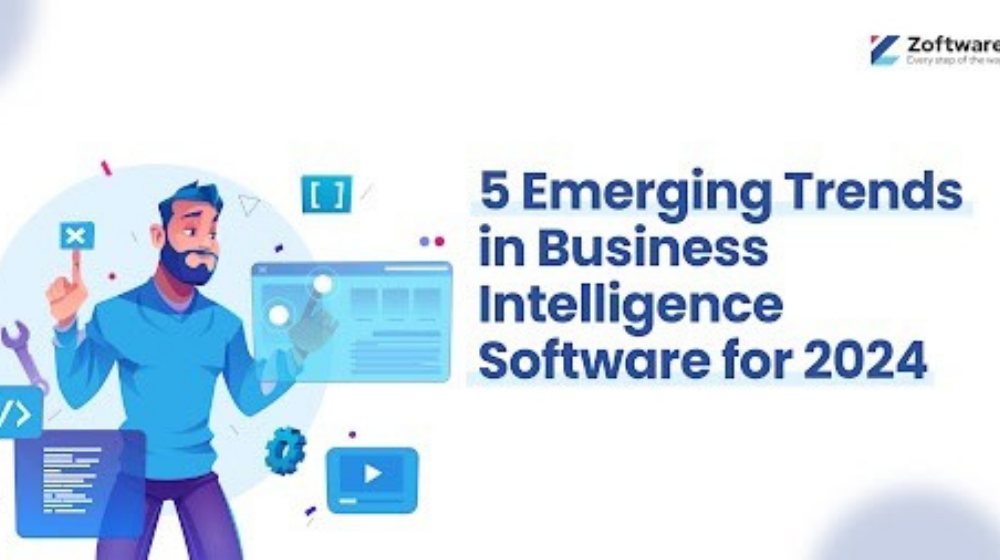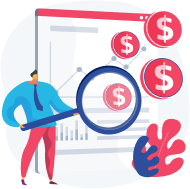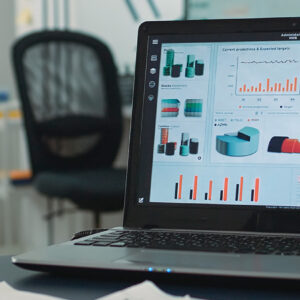The worldwide market for business intelligence is experiencing significant growth, and it is forecasted to achieve a value of $41.94 billion by the year 2030.
This is the outcome of business intelligence software in the market. BI has been significantly improving the way businesses used to be. And business leaders are actively looking for the latest trends in BI to stay ahead of the competition.
This blog will explore the five emerging business intelligence software trends. And how they will be helpful for your business.
Here you go!
5 Emerging Business Intelligence Software Trends :
- Augmented Analytics
Augmented analytics is one of the emerging business intelligence software trends that enhances data analysis with the help of advanced technological tools. Artificial intelligence (AI) and machine learning (ML) are used for data analysis.
These tools allow you to automatically process raw data and provide actionable insight with less hassle. This trend shows the transition from traditional data analytics to automated methods.
Features of Augmented Analytics:
- Automated data preparation: This analytics allows you to automate the data analysis. It breaks the complex raw data into valuable insights and reduces human intervention.
- Advanced data analysis techniques: With the help of AI and ML, augmented analytics gathers data and evidence to analyze, which traditional methods sometimes fail to perform.
- Natural Language Processing: It uses machine language and allows nontechnical users to access and interact with data using conventional language.
- Data visualization enhancements: Augmented analytics represent complex data in interactive visualizations. This helps in a better understanding of data.
- Proactive alerts: With the help of advanced techniques and interactive data visualization, it proactively alerts users. And provide changes in data and suggest actions.
Application of Augmented Analytics:
- Business strategy formulation: These analytics analyze comprehensive markets and competitors. Also, to recognize new business opportunities.
- Marketing and customer insights: These analytics are used by businesses to understand customer behavior and market trends better. This helps in recreating marketing strategies.
- Operational Efficiency: These analytics help optimize operational processes by analyzing performance data and identifying areas for improvement.
- Financial Analysis: It provides advanced financial reporting and predictive analysis, aiding in budgeting, forecasting, and risk assessment.
- Human Resources Management: In HR, augmented analytics is used for talent analytics, workforce planning, and employee performance analysis.
- Healthcare Data Analysis: It’s applied in healthcare for patient data analysis, treatment optimization, and research data management.
2. Embedded Analytics
Embedded analytics is one of the latest trends in business intelligence software. It is marked by its advanced integration and seamless integration of analytical power with user experience. Businesses increasingly recognize the value of embedded analytics in their core systems – from CRM to ERP. It provides immediate insights into where and when they are needed.
This approach enhances efficiency, develops a data-driven culture, and supports more informed decision-making across organizations.
Features of Embedded Analytics
- Advanced Integration: Beyond basic data visualization, embedded analytics offers deeper integration. They provide more complex analytical capabilities within business applications.
- Real-time Analysis Data: It enables instant analysis and reporting. It allows businesses to respond swiftly to changing market dynamics.
- Customizable Dashboards: Users can tailor analytics tools to their specific needs. They can create personalized dashboards that highlight relevant data points.
- Predictive and Prescriptive Analytics: Advanced algorithms provide descriptive insights and predictive and prescriptive analytics. It suggests future actions based on data trends.
- Enhanced User Experience: With a focus on user-friendly interfaces, these tools make data analysis accessible to nontechnical users. It enhances the broader engagement.
- AI and Machine Learning Integration: Incorporating AI and ML algorithms offers sophisticated analysis and automates repetitive analytical tasks.
Applications of Embedded Analytics
- Customer Relationship Management (CRM): This BI software trend provides sales and marketing teams with insights directly within their CRM systems. It enhances customer engagement strategies.
- Enterprise Resource Planning (ERP): Embedded analytics offers real-time operational data analysis. This analysis helps optimize resource allocation, financial planning, and supply chain management.
- Human Resources Management (HRM): This trend assists in analyzing employee performance, managing talent, and optimizing workforce allocation.
- Healthcare Management: It offers providers insights into patient care and operational efficiency. And resource management directly within their healthcare management systems.
- E-Commerce and Retail: It helps provide retailers with immediate insights into customer behavior, inventory levels, and market trends.
- Financial Services: Helps in risk management, fraud detection, and personalized financial advice by embedding analytics in banking and investment applications.
3. Data Governance and Privacy
Among all emerging business intelligence software trends, this trend is known for its recognized value globally. This emergence is primarily due to heightened global awareness and regulatory demands concerning data security and user privacy. Companies increasingly recognize the importance of implementing robust governance frameworks to manage data effectively and ethically.
Features of Data Governance and Privacy
- Structured Data Management: Data governance involves organizing and maintaining data systematically. It ensures accuracy, quality, and accessibility in compliance with both internal standards and external regulations.
- Privacy Compliance: Following regulations like GDPR, CCPA, and others, data privacy within governance frameworks involves policies and procedures to protect sensitive information from unauthorized access or breaches.
- Risk Management: This trend helps in the proactive identification, assessment, and mitigation of risks related to data security, privacy breaches, and non-compliance with regulations.
- Ethical Data Utilization: It establishes guidelines for ethical data usage that align with organizational values and societal norms.
- Transparency and Accountability: It ensures transparent data handling processes and establishes clear lines of accountability within the organization.
- Audit Trails and Reporting: Implementing mechanisms for creating audit trails and generating comprehensive reports to demonstrate compliance and governance efficacy.
Applications of Data Governance and Privacy
- Regulatory Compliance: Assisting organizations in adhering to various data protection laws and avoiding substantial fines and reputational damage.
- Enhanced Decision Making: Providing high-quality, well-governed data that leads to more accurate and reliable business intelligence software insights.
- Risk Reduction: Minimizing the risks associated with data breaches, leaks, and misuse by implementing stringent governance protocols.
- Customer Trust: Building customer confidence through transparent and secure data practices enhances brand reputation and customer loyalty.
- Operational Efficiency: Streamlining data management processes, thus improving operational efficiency and reducing the likelihood of errors.
- Data Monetization: Safely leveraging data assets while respecting privacy norms and legal constraints.
4. Blockchain-Driven Development
Blockchain-driven development is an emerging trend in business intelligence software that introduces new data security, transparency, and decentralization models. It uses the power of blockchain technology to improve the data analysis process. And with this process, one can make better strategic decisions.
Features of Blockchain-Driven Development
- Decentralized Data Handling : Blockchain technology shifts data management from the conventional centralized approach of traditional BI systems to a distributed model. This setup spreads data across a network, significantly diminishing the risks associated with centralized data vulnerabilities.
- Robust Data Security : Thanks to its cryptographic foundation, blockchain technology ensures the integrity and security of data. It encrypts and connects each transaction to its predecessor, forming an immutable chain.
- Transparency Enhancement : The ledger system inherent in blockchain technology guarantees the visibility and traceability of every data transaction. This aspect is crucial for organizations prioritizing high audibility levels and adherence to regulatory standards.
- Smart Contracts: They are self-executing contracts with the terms of the agreement between buyer and seller directly written into lines of code. They automate processes and transactions, enhancing efficiency.
- Reduced Costs: By streamlining processes and reducing the need for intermediaries, blockchain can significantly reduce data management and analysis costs.
Application of Blockchain-Driven Development
- Supply Chain Management: Blockchain provides an unalterable record of goods moving through the supply chain, enhancing traceability and efficiency.
- Financial Services: It improves the accuracy and security of financial transactions and reporting, which is crucial for BI in finance.
- Healthcare Data Management: Blockchain ensures the security and confidentiality of patient data while providing a transparent record for healthcare providers.
- Retail and Consumer Analytics: Retailers can use blockchain for better inventory management and to gain deeper insights into consumer behavior.
- Risk Management: The immutable and transparent nature of blockchain aids in more effective risk analysis and mitigation strategies.
- Compliance and Auditing: Blockchain simplifies compliance reporting and auditing processes, ensuring data integrity and reliability.
5. Advanced Data Visualization
Advanced data visualization is a pivotal trend in the dynamic business intelligence (BI) software trends, revolutionizing how businesses interpret complex data. This trend extends beyond conventional charts and graphs, offering deeper insights through more sophisticated, interactive, and intuitive visual representations.
The essence of Advanced Data Visualization lies in its ability to transform vast and complex data sets into clear, actionable insights, enabling decision-makers to grasp intricate patterns, trends, and correlations that might otherwise remain obscured in traditional analytical methods.
Features of Advanced Data Visualization
- Interactive Dashboards: These panels facilitate an immersive data exploration experience, featuring dynamic elements such as drill-down options, adjustable sliders, and filters that enable personalized viewpoints.
- Real-Time Data Visualization: This characteristic allows for the immediate portrayal of data, granting organizations the agility to respond quickly to evolving trends and shifts in the market.
- Multi-Dimensional Analysis: Tools in Advanced Data Visualization equip users to scrutinize data from several angles and layers, enhancing the analytical depth and understanding.
- Predictive Analytics Integration: By integrating with predictive analytics, these tools represent historical data and forecast future trends and patterns.
- Customization and Flexibility: Users can tailor visualizations to meet specific needs, creating charts, graphs, and diagrams that align with their unique business objectives.
- Enhanced User Experience: With an emphasis on user-friendly interfaces, these tools make complex data analysis accessible to users of varying technical expertise.
- Collaboration Features: Modern visualization tools often include capabilities for sharing and collaborating on visualizations, facilitating better team coordination and decision-making.
Applications of Advanced Data Visualization
- Market Trend Analysis: Businesses use advanced visualization tools to identify and act on emerging market trends, gaining a competitive edge.
- Financial Reporting: Complex financial data is understandable and actionable, aiding in better investment and budgeting decisions.
- Healthcare Data Management: In healthcare, these tools help visualize patient data, treatment outcomes, and epidemiological trends, contributing to enhanced patient care and research.
- Risk Management: By visualizing various risk factors, organizations can more effectively foresee and mitigate potential risks.
- Operational Performance Tracking: Organizations utilize these tools to monitor and optimize their operational efficiency, spotting areas for improvement.
Conclusion
You will find many more business intelligence software trends followed by different businesses. But what fulfills your business requirement should be your only focus.
Well, fret not—assistance is at hand with Zoftware
It is a software discovery platform in the Middle. A one-stop destination to cater to your BI software needs. The platform simplifies finding software by allowing businesses to specify their requirements, compare various software options, and make informed decisions based on genuine user feedback.
Register now to get the trending business intelligence software for your enterprise.





